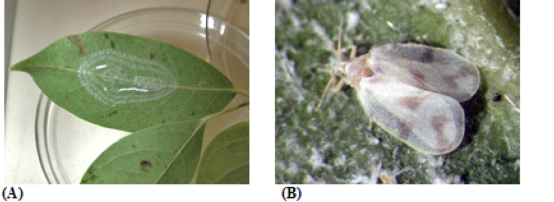Insect Hot Topics: Two New Pests from Florida
by James A. Bethke
This new column focuses on insects that pose a threat to the ornamental plant production industry and have good potential for invasion and establishment in California.
Fig Whitefly
The fig whitefly (Singhiella simplex), which is also sometimes called the “ficus whitefly,” (fig. 1) is a new U.S. continental record. The insect was first found in 2007 in Homestead, Florida (Miami-Dade County) on ficus trees and hedges, and it spread to both Broward and Palm Beach counties by 2008. Populations grew to incredible levels during the next couple of years.

Fig. 1. The fig whitefly is a new invasive pest in Florida that defoliates ficus trees. (A) eggs and (B) nymph and adults. Photo courtesy of Katharine Mannion.
One of the most obvious symptoms of fig whitefly attack is the presence of defoliated ficus trees. Ficus, as you are aware, are very densely packed trees, and hedges and can be used as a barrier between buildings and yards. However, when attacked by this insect, the plants look completely bare. Further, this whitefly is reportedly causing severe branch dieback and even killing ficus trees and hedges.
The most common fig tree attacked is the weeping fig (Ficus benjamina) but Katharine Mannion (University of Florida) reports that it can also be found on lofty fig (also called “false banyan tree” [F. altissima] ), banyan tree (F. bengalensis), Cuban laurel (F. microcarpa), strangler fig (F. aurea), fiddle-leaf fig (F. lyrata ) and banana-leaf fig (F. macllandii [= F. binnendijkii] ) .
Defoliation usually occurs after the whiteflies have been there for several generations, so Dr. Mannion suggests that you monitor your ficus plants for early signs of an infestation because it will be easier to manage the pest before it builds to high populations. Also, if infested trees or hedges are trimmed, bag the clippings to reduce the chance of spread.
Here are a few websites that have pictures, descriptions, and a distribution map of the pest:
Fresh from Florida: Pest Alert-Fig Whitefly
Fresh from Florida: Fig Whitefly Updates
University of Florida: The Fig Whitefly
Naples Daily News: At Home-Fig Whitefly
Rugose Spiraling Whitefly
The rugose spiraling whitefly (Aleurodicus rugioperculatus) is another new whitefly in Florida (fig. 2), first found in Dade County in 2009. This insect has a larger host range than the fig whitefly. Hosts include gumbo limbo (Bursera simaruba), Calophyllum species, black olive (Bucida buceras), copperleaf (Acalypha wilkesiana), broadleaf arrowhead (Sagittaria latifolia), cocoplum (Chrysobalanus icaco), Brazilian pepper (Schinus terebinthifolius), wax myrtle (Myrica cerifera), live oak (Quercus virginiana), mango (Mangifera indica), areca palm (Dypsis lutescens), Veitchia species and coconut (Cocos nucifera).

Fig. 2. The Rugose Spiraling Whitefly is a new invasive pest in Florida with a wide host range. (A) eggs, (B) adult. Photo courtesy of Katharine Mannion.
The most noticeable symptoms of an infestation of this whitefly are the abundance of the white, waxy material covering the leaves and excessive sooty mold. This whitefly is much larger than typical whiteflies and somewhat resembles the giant whitefly (Aleurodicus dugesii). They make similar waxy patterns on the undersides of the leaves as well.
It is likely that establishment of these whiteflies will occur in the landscape first since most landscape plants are typically not treated for pests, whereas they are in the ornamental plant production industry. However, when populations build, they will most certainly cause havoc in the plant production industry as well. To learn more about the rugose spiraling whitefly, see Dr. Mannion’s web site.
James Bethke is Farm Advisor for Nurseries and Floriculture, UC Cooperative Extension, San Diego County.












